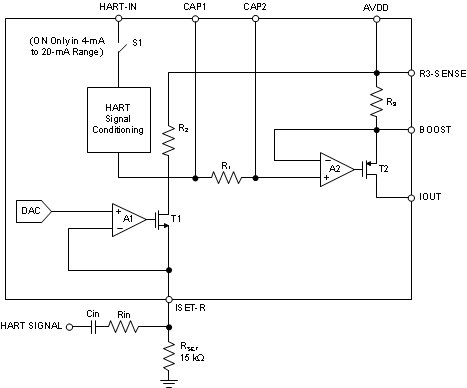ZHCSC70D December 2013 – December 2021 DAC7750 , DAC8750
PRODUCTION DATA
- 1 特性
- 2 应用
- 3 说明
- 4 Revision History
- 5 Device Comparison Table
- 6 Pin Configuration and Functions
- 7 Specifications
- 8 Detailed Description
- 9 Application and Implementation
- 10Power Supply Recommendations
- 11Layout
- 12Device and Documentation Support
- 13Mechanical, Packaging, and Orderable Information
封装选项
机械数据 (封装 | 引脚)
散热焊盘机械数据 (封装 | 引脚)
订购信息
9.1.1.2 Using the ISET-R Pin
The second method to implement HART is to couple the HART signal through the ISET-R pin when IOUT is operated using an external RSET resistor. The FSK signal from the modem is ac-coupled into the pin through a series combination of Rin and Cin as shown in Figure 9-2.
 Figure 9-2 Implementing HART with
the ISET-R pin
Figure 9-2 Implementing HART with
the ISET-R pinThe magnitude of the ac-current output is calculated with Equation 6.
Equation 6. (VHART × k) / Rin
where
- VHART is the amplitude of the HART FSK signal from the modem
- k is a constant that represents the gain transfer
function from the ISET-R pin to the IOUT pin and depends on the selected current
output range as follows:
- k = 60 for the 4-mA to 20-mA range
- k = 75 for the 0-mA to 20-mA range
- k = 90 for the 0-mA to 24-mA range
The series input resistor and capacitor form a high-pass filter at the ISET-R pin. Select Cin to make sure that all signals in the HART extended-frequency band pass through unattenuated.